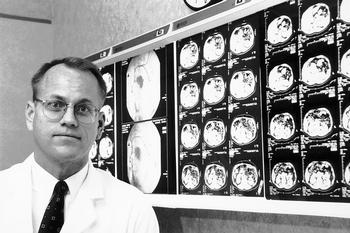New techniques help spot pancreatic cancer more quickly

Dr. Steven Leach is investigating new ways to detect pancreatic cancer. (Photo by Donna Jones Bailey)
Novel approaches are being used at the Vanderbilt Cancer Center to detect and diagnose pancreatic cancer early enough to offer hope for a cure.
Physicians in the multidisciplinary Pancreatic Cancer Treatment Program say that new imaging techniques being applied can detect small, contained tumors that would be missed using traditional CT scanning. And a new biopsy method has been developed that can provide a reliable tissue diagnosis without surgery.
"Early diagnosis makes all the difference in the world in pancreatic cancer," said Dr. Steven D. Leach, assistant professor of Surgery and director of the program.
"The overall survival rate for pancreatic cancer after three years is only 3 percent, so it's literally one of our most lethal cancers. On the other hand, if we can detect tumors when they're smaller than two centimeters and before they have spread to adjacent lymph nodes, the five-year survival rate approaches 50 percent."
Such small pancreatic tumors are usually not visible with CT scan, a traditional imaging test used to detect pancreatic cancer.
"So these new techniques allow us for the first time to think about starting treatment at a much earlier stage, when we have at least some hope for a cure in what has long been a fatal tumor," Leach said.
The pancreas is a long, thin organ in the abdomen with two basic jobs: making digestive juices to break down food and making hormones, including insulin, that regulate how your body uses and stores food.
Pancreatic cancer, which strikes about 28,000 and kills about 26,000 in the United States each year, is the 10th most common cancer but ranks fifth as a leading cancer killer.
Its symptoms ‹ if there are any ‹ may be vague and resemble other illnesses. They may include nausea, pain in the upper to middle of the abdomen, weight loss and sometimes jaundice. Often, pancreatic cancer is not diagnosed before it has spread to other organs.
The Pancreatic Cancer Program of the Vanderbilt Cancer Center includes a team of physicians, nurses and other caregivers dedicated to beating these grim odds with innovative approaches to detection, diagnosis and treatment of pancreatic cancer.
One of the new detection approaches developed in the past year uses PET (Positron Emission Tomography) scanning with fluorodeoxy glucose (FDG). The radioactively tagged glucose is taken up and metabolized by tumor cells, especially pancreatic tumor cells, in a way that distinguishes the cancer from normal cells.
So far, more than 60 patients with suspected pancreatic cancer have undergone FDG-PET scanning, Leach said. The scan is 93 percent accurate at identifying the pancreatic tumors, compared to 67 percent sensitivity for the traditionally used CT scan.
"We are very excited by the findings that FDG-PET is more accurate than CT in detecting small pancreatic tumors," said Dr. Dominique Delbeke, associate professor of Radiology and Radiological Sciences, Leach's collaborator in the FDG-PET research.
"In addition, because PET is a whole body technique, FDG-PET can identify metastases to the liver. That is important because patients who have metastases to the liver are not candidates for curative surgery."
Vanderbilt is the only hospital in Middle Tennessee with FDG-PET scan capability, and the Vanderbilt Cancer Center is the only center in the country using PET to stage potentially resectable pancreatic cancer.
A second new detection approach is being used by Leach and Dr. Howard R. Mertz, assistant professor of Medicine. Called endoscopic ultrasound, or EUS, it involves an endoscope placed down the throat, past the stomach and into the duodenum, the first part of the small intestine, adjacent to the pancreas. Ultrasound waves emitted from the tip of the endoscope through the pancreas can detect tumors with 100 percent accuracy, based on the 30 cases done so far.
"For small pancreatic cancers, EUS is generally the only technique that will allow visualization of tumors," Mertz said. "For larger pancreatic tumors, EUS provides a superior view of the blood vessels that may be involved. That is a key piece of information in deciding whether to do surgery."
Mertz is also using EUS to guide fine-needle biopsy of pancreatic tumors. The technique has been used in about 20 patients. Accuracy for this procedure has improved to 100 percent in the most recent cases.
"There's evidence that EUS can prevent patient suffering and save money by preventing surgeries that would be of no benefit," Mertz said.
The Vanderbilt Cancer Center is the only center in the region to offer EUS detection and EUS-guided biopsy and is a leading center in the southeast to use this approach in pancreatic cancer.
Leach called the developments of FDG-PET and EUS in pancreatic cancer a "huge advance."
"For years and years, the pancreas has been considered an inaccessible organ because it is located deep in the back of the abdominal cavity, behind the stomach, behind major, important blood vessels," Leach said. "The idea that we can do a biopsy without surgery is just amazing."
Confirming a diagnosis of pancreatic cancer without surgery enables physicians to use the very latest approach to treatment, giving a combination of chemotherapy and radiation up front to shrink the tumor before surgery. Called neoadjuvant therapy, this approach increases the chances that the tumor can be completely removed, optimizing the patient's chances for cure.
Equally important, Leach said, is that the EUS-guided biopsy enables patients who have non-operable tumors to avoid surgery altogether.
"These are patients who, unfortunately, have only a few months to live, and the last thing you want to do is take up that valuable time recovering from surgery," he said.
For additional information about FDG-PET and EUS in pancreatic cancer, contact the Pancreatic Cancer Program web site at www.mc.vanderbilt.edu/surgery/pncnprog.html.













